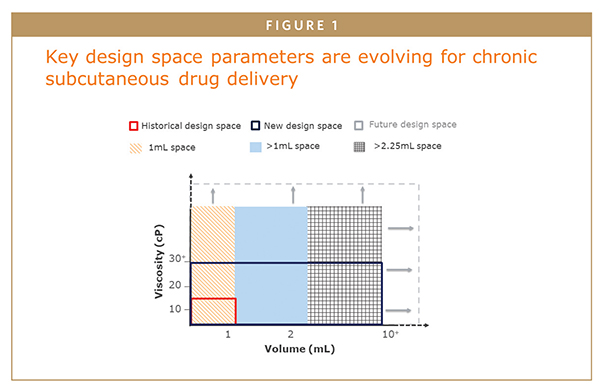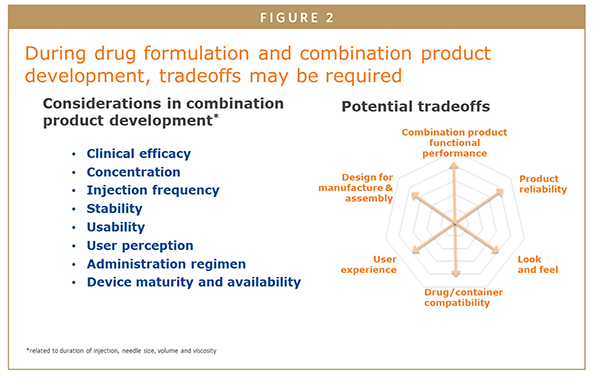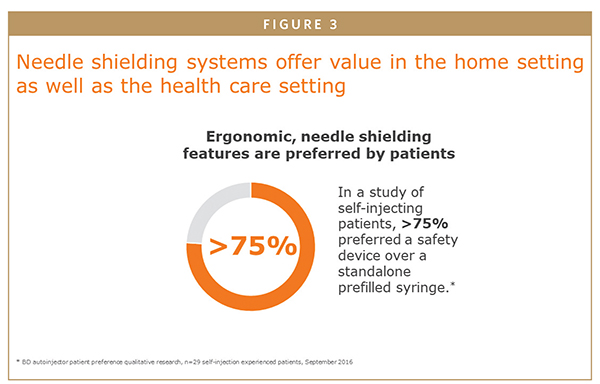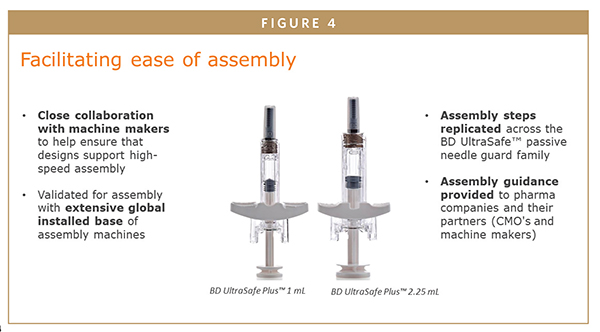Issue:October 2021
DEVICE DEVELOPMENT - Selecting Drug Delivery Systems for Higher Doses, Higher Viscosities & Lower Risk
INTRODUCTION
The development of new parenteral biologics with high-volume, high-viscosity formulations (> 1 mL, >15 cP) is triggering the need for devices that can deliver these therapies with the ease, safety, and low injection time required for self-injection.1-3 As these formulations come to market, pharmaceutical and biotech companies must make critical device choices from an array of largely unproven options.2 The following discusses how companies can de-risk their device selection as they bring this new generation of high-volume, high-viscosity biologics to market.
IDENTIFYING SOURCES OF RISK IN COMBINATION PRODUCT DEVELOPMENT
Particularly risk-prone areas of combination product development involving a primary container and secondary packaging are performance and safety. Fundamental sources of risk include incompatibility with the drug or primary container, or failure to meet usability requirements. One consequence associated with poor selection of a new injection device could be missed regulatory milestones leading to a delayed launch and the associated lost revenue. A second consequence is the potential for high reject rates during development and industrial scale-up, potentially leading to higher costs or delays. Biopharmaceutical companies launching high-volume or high-viscosity formulations must adopt strategies and plan ahead to reduce these risks.
THE LIMITS & TRADEOFFS OF EXISTING SELF-INJECTION SYSTEMS
Autoinjectors and ergonomically optimized manual injectors are two delivery technologies often chosen for fixed-dose biologics given by self-injection. Some drugs are offered in both delivery formats, reflecting a variety of market needs and user preferences.4 Auto and manual injectors each offer a different set of advantages and tradeoffs to end users and biopharmaceutical companies. Both technologies include ergonomic features that can mitigate challenges in delivering self-injections, such as high injection force, patient discomfort, and pain perception.1,4,5 Both technologies also offer needle protection. Autoinjectors can help patients who lack the strength or dexterity to inject; however, not all autoinjectors are capable of delivering higher viscosities (>15 cP).4 Manual injection systems allow users to control the speed of injection and may be able to handle higher viscosities, but they typically entail more steps for end users, and require greater force to operate, compared to autoinjectors.6-8
RECONCILING COMPETING DESIGN REQUIREMENTS
Given the relative lack of commercialized delivery solutions in the 2 mL and greater, high-viscosity space compared with the ≤1 mL space, biopharmaceutical companies developing combination products with drug delivery devices face important challenges, especially because increases in volume and viscosity may push device design constraints towards unacceptable limits (Figures 1 & 2).2 Competing requirements, such as injection time, injection force, ergonomics, patient comfort, and system reliability thus provide a formidable challenge for delivery system designers.3,5,9,10 For example, to achieve an acceptable injection time with a higher volume or viscous solution, a higher injection force is often required, which in turn must be reconciled with system reliability over the intended shelf life. A higher injection force may be achieved by increasing the spring force, resulting in greater pressure within the system, which may challenge performance over the shelf life – elevating the importance of integration among components as a critical factor in achieving reliable system performance. Higher volume or higher viscosity drugs can increase the system integration challenge.


Further complicating device selection and integration is the development stage at which the primary container is chosen, typically before Phase 3, to allow time for stability testing, and prior to development of the delivery system.11
The primary container serves important functions, including storing and aiding delivery of the drug product. Therefore, the primary container should not only be compatible with the drug product, but it should also enable the delivery system (such as an autoinjector) to meet delivery requirements. To maintain maximum flexibility in the context of a rapidly evolving market for biologics, biopharmaceutical companies may wish to select a primary container and stopper that work well with a number of secondary delivery systems to help support lifecycle management, or to leverage a single packaging or delivery platform for multiple drug products. Unfortunately, not all primary containers and stoppers are compatible or well-integrated with complex self-injection systems.9
Biopharmaceutical companies will face some or all of these uncertainties as they define new systems to deliver their high-volume or high-viscosity formulations. Preventable device-related pressure points that could lead to delayed timelines include the following:
- Poor performance or reliability of the combination product caused by poor fit at component interfaces or degradation over time;
- Failure to achieve regulatory approval on time, due to issues with combination product functionality for its intended use; and
- High reject rate during industrial scale-up, leading to project delays while resolving the problem.
DE-RISKING DELIVERY DEVICE DEVELOPMENT – BEST PRACTICES
There are a number of steps that can help de-risk the process of choosing the primary container and the delivery system for higher volume or higher viscosity biologics.
Anticipate
Consider all drug delivery requirements early in development. This includes target tissue, frequency of administration, dose volume and viscosity, patient capabilities and preferences, market standards for drug administration, drug-container compatibility, primary container geometry, and fit with desired delivery systems.
Consider All Requirements Up Front
Having an incomplete picture of key requirements for both the primary container and the delivery system can cause challenges later in development – in Phases 2b or 3, registration, launch, and life cycle management – which can be difficult to resolve while holding to both timeline and budget.
Choose an Experienced Device Development Team
The core project team should be well connected and should include cross-functional representation, such as formulations, primary packaging, delivery device, commercial, clinical, quality, regulatory, pharmaceutical development, medical affairs, and manufacturing that can ask insightful and experience-based questions and drive robust decision making throughout product development.
Select Critical Components of the Combination Product Based on Combined Requirements
Testing is conducted using the full system consisting of drug, primary container, stopper, and delivery system. Fit and functionality between the various constituents should be carefully evaluated for performance and reliability before the selection of components is finalized. Unfortunately, allowing sufficient time for thorough evaluation is not always possible due to the complex and iterative nature of system evaluations. Some parameters are often fixed (eg, dose volume and viscosity, or prefillable syringe type, if selected in early Phase 2), while others are not. If the delivery system doesn’t function as intended, components may need to be adjusted or replaced or, in extreme cases, selection of an entirely different system may need to occur, thereby affecting the project timeline and budget. In addition, parts may come from multiple suppliers, requiring a potentially more intensive effort to coordinate system level evaluations.
CHOOSING A PARTNER TO HELP MANAGE COMPLEXITY
Project complexity and the risks associated with developing combination products for biologics may be reduced by partnering with a device manufacturer with a high level of primary container and secondary packaging experience and who understands the most sensitive integration points. Risk can be further reduced if that partner adopts a “quality by design” philosophy in developing primary containers and delivery systems that function together. Beyond effective integration, data and support services are also critical components of success in developing combination products. For biopharmaceutical companies, having additional data that complements the combination product regulatory submission can reduce the quantity of testing required and can also provide assurance of meeting delivery system requirements, while helping to de-risk the overall development process.
DRUG DELIVERY SYSTEMS: A CHECKLIST FOR SUCCESS
What are the components of a successful biologic drug delivery system? First, it should be user-friendly (Figure 3), meaning that it has been successfully tested with diverse target user groups, including patients with varying capabilities and characteristics, if intended for self-injection.3 A drug delivery system should also incorporate experience from commercialized solutions that are broadly used in the market, which can potentially reduce risk when incorporated into combination products. Finally, the system should be robust, effectively integrated, and compatible with established primary containers for biologics. Addressing these criteria can increase the likelihood of compatibility with the drug, and of the combination product’s reliable performance throughout launch and commercialization.

BD ULTRASAFE PLUSTM 2.25 ML PASSIVE NEEDLE GUARD: PART OF A FULL-SOLUTION APPROACH FOR BIOLOGICS
BD UltraSafe PlusTM 2.25 mL is now available to address biologic drug delivery needs, and together with prefillable syringes is capable of delivering up to 2 mL and 30 cP solutions.8 An ergonomic manual injection system with passive needle shielding, its design is similar to the BD Ul traSafe PassiveTM and BD UltraSafe PlusTM 1 mL needle guards, of which more than 1 billion units have been sold since 2010.12 The BD UltraSafeTM product family has a history of commercial use by both healthcare providers and patients, and has been used in a wide variety of therapeutic settings.12
A human factors validation study has shown that injections given with BD UltraSafe PlusTM 2.25 mL can be successful and sufficiently acceptable up to 2 mL and 30 cP*.7 The study, conducted with a broad range of users including dexterity-challenged patients, found the system to be usable across all studied viscosities. There was no decline in usability results from 1 cP to 18 cP and up to 30 cP. With a 30 cP solution, the rate of full-dose delivery was still high, at 95% of injections fully delivered. Upon full-dose delivery into an injection pad, the needle guard was consistently activated. More than 95% of users were confident or very confident that the activated BD UltraSafe PlusTM safety mechanism would protect them from needlestick injuries**.
* When tested with a standard syringe for viscous biologics, the BD NeopakTM 2.25 mL Glass Prefillable Syringe with a 27G special thin wall 12.7 mm needle.
** Rated on a Likert scale of 1 to 6, from “Not At All Confident” to “Very Confident.”
COMPATIBLE WITH A LEADING PRIMARY CONTAINER FOR BIOLOGICS
BD UltraSafe PlusTM 2.25 mL is compatible with a platform solution for biologics, the BD NeopakTM 2.25 mL prefillable syringe.13 The BD NeopakTM Glass Prefillable Syringe platform benefits from an optimized manufacturing process to become BD’s highest standard in prefillable syringes, helping to de-risk biologic drug development and time to market. Through quality by design, process control, and system interface specifications, BD NeopakTM supports autoinjector compatibility.14-16 This may help enable cost and time savings in developing a single primary container that may fit with multiple systems, when several different secondary delivery formats may be desired. The BD NeopakTM 2.25 mL provides the flexibility required to be leveraged as a platform solution.
Additionally, the BD NeopakTM platform technology is designed to ensure robust compatibility and reliable performance with BD self-injection systems, such as the BD InteviaTM 1 mL and 2.25 mL two-step Disposable
Autoinjectors ***.
*** BD InteviaTM 2.25 Disposable Autoinjector is a product in development; some statements are forward looking and are subject to a variety of risks and uncertainties. BD InteviaTM Disposable Autoinjectors are device components intended for drug-device combination products and not subject to FDA 510(k) clearance or separate EU CE mark certification.
ULTRA-THIN WALL, 8 MM NEEDLE TECHNOLOGY – ENHANCING BD ULTRASAFE PLUSTM PERFORMANCE
The newly developed BD NeopakTM XtraFlowTM Glass Prefillable SyringeϮ been designed to improve the subcutaneous delivery of drugs with high viscosities by enhancing the injection experience through a reduction in injection effort or time.7,17,18 BD recently tested the benefits of the BD UltraSafe PlusTM 2.25 mL needle guard in combination with the BD NeopakTM XtraFlowTM (8mm, 27G ultra-thin wall needle) prefillable syringe.19 More than 120 injections of a 30 cP solution were simulated in a human factors study. Directional results indicate that subjects perceived a reduction in the force needed to push the plunger during injection when using BD UltraSafe PlusTM 2.25 mL and BD NeopakTM XtraFlowTM 2.25 mL together. The percentage of users who rated the plunger as “easy or very easy to push” more than doubled from 15% (standard syringe) to 41% (BD Neopak XtraFlowTM syringe)ϮϮ UltraSafe Plus mL passive needle guard, when combined with BD NeopakTM XtraFlowTM prefillable syringe, may provide a better experience for end users, including self-injecting patients.
Ϯ NeopakTM XtraFlowTM Glass Prefillable Syringes are products in development; some statements are forward looking and are subject to a variety of risks and uncertainties.
ϮϮ Rated on a Likert scale of 1 to 6, from “Very Difficult” to “Very Easy.”
REDUCE YOUR RISK FROM DEVELOPMENT TO SCALE-UP
At BD, we leverage our primary container expertise and extensive experience in prefillable syringes to develop drug delivery systems that perform reliably against stringent performance standards and requirements.20 Incorporating this expertise into combination product development can reduce the likelihood that integration issues will occur during development, at scale-up, or after commercial launch.
BD undertakes important steps that help to ensure that the assembly process of combination products involving several different components can be scaled up with the requisite speed and quality, while minimizing waste. Careful attention to the design of the assembly process addresses an important risk point for biopharmaceutical companies that depend on the smooth integration of the primary container and secondary delivery system at speed and during industrialization.21 With the design of BD UltraSafe PlusTM 2.25 mL, BD aims to decrease assembly risk for our biopharmaceutical partners to help shorten the high-speed assembly start-up curve, reduce costs, and lower the risk of on-market failures (Figure 4).

BD: A FULL-SOLUTION PARTNER
BD offers services and data that complement biopharmaceutical partners’ combination product development capabilities and expertise (Figure 5). This includes assembly guidance, combination product testing services, designs validated with thorough and rigorous human factors testing, validated platform IFUs (instructions for use), and access to small development quantities and regulatory-compliant data packages through the BD PartnerPathTM program.22 These services aim to help our partners limit development complexities related to primary containers and secondary delivery systems, and to reduce risk to timelines and cost.
EXTEND YOUR OPTIONS WITH THE BD ULTRASAFE PLUSTM 2.25 ML PASSIVE NEEDLE GUARD
BD UltraSafe PlusTM 2.25 mL passive needle guard is an ergonomic accessory for manual injection that can complement biopharmaceutical companies’ total offering to address patients’ needs in both manual injector and autoinjector formats, and can help support the market launch of viscous (up to 30 cP) 2 mL drug therapies. With extensive experience in the end-to-end integration of combination products and a platform approach based on BD NeopakTM 2.25 mL, BD offers capabilities, experience, and a suite of solutions, including the BD UltraSafe PlusTM 2.25 mL passive needle guard, to companies seeking to minimize the risk and optimize the success of their high-volume, high-viscosity biologic therapies.
REFERENCES
- Wright, J.M., & Jones, G.B. (2017 December). Developing the Subcutaneous Drug Delivery Route. Medical Research Archives, 5(12). Watt, R. P. et al. (2019). Injectability as a function of viscosity and dosing materials for subcutaneous administration. International Journal of Pharmaceutics, 554 (2019): 376-386.
- IQVIA dataset, extracted on December 26th, 2019, from IQVIA Smart MIDAS’ on-line platform. 2H 2016 to 1H 2019. https://smartmidas.imshealth.com/.
- Collins, D. S. et al. (2020). Accelerating the development of novel technologies and tools for the subcutaneous delivery of biotherapeutics. Journal of Controlled Release, 321 (2020): 475-482.
- van den Bemt, J. F. et al. (2019), “A portfolio of biologic self-injection devices in rheumatology: how patient involvement in device design can improve treatment experience”, Drug Delivery, Vol. 26 (1), p. 384-392.
- Agrawal, N. J. et al. (2016), “Computational Tool for the Early Screening of Monoclonal Antibodies for Their Viscosities”, MAbs, Vol. 8 (1), p. 43-48.
- BD Self-Injection Safety System Selection Qualitative Market Research [internal study], Le Pont-de-Claix, France; Becton, Dickinson and Company, 2019.
- BD Autoinjector Patient Market Research, September 2016.
- Human Factors Study – PHS-18-09 BD UltraSafe Plus™ 2.25 ml passive needle guard, December 2019.
- System Integration Challenges in Combination Products for Injectable Drugs [internal study], Le Pont- de-Claix, France; Company, 2016.
- Cilurzo, F. et al. (2011). Injectability Evaluation: An Open Issue. AAPS PharmSciTech, 12(2): 604-609.
- FDA Guidance for Industry, INDs for Phase 2 and Phase 3 studies: Chemistry, Manufacturing, and Controls Information, May 2003.
- BD internal data.
- R&D Documents ERD20192253 rev02, ERD20194103 rev01, and ERD21094192 rev01.
- BD NeopakTM Process verification [Internal Study]. Pont-de-Claix, FR: Becton Dickinson and Company; 2014.
- Silicone quality and Silicone profile [Internal Study]. Pont-de-Claix, FR: Becton Dickinson and Company; 2017.
- Neopak Injection time [Internal Study]. Pont-de-Claix, FR: Becton Dickinson and Company; 2018.
- Human Factors Formative Study – Usability and Acceptance of a New Syringe Compared to Standard for 2.25 mL BD Neopak™ Syringes”. Internal Study, BD, 2019.
- Injection time and ejection force calculation”. Internal Study, BD, 2020.
- Pager, A. et al. (2020), “User experience for manual injection of 2mL viscous solutions is enhanced by a new prefillable syringe with a staked 8 mm ultra-thin wall needle”, Expert Opinion on Drug Delivery, DOI: 10.1080/17425247.2020.1796630.
- BD WW Demand Database, WW Sales 2012-2018 for APAC, EU, US, LA; BD R&D System Integration data generation plan road map; BD Quality System complaint data (2012-2018), Physioject complaint extract for reported user complaints related to system integration.
- Overview of Assembly Steps and Strategy for BD UltraSafe Passive and Plus.
- CDFM Assembly Guidance for UltraSafe Plus and REF-20520 CDFM Assembly Guidance for UltraSafe Add-on Finger Flange.

Nicolas Bralet is Worldwide Safety Platform Leader at BD Medical-Pharmaceutical Systems, responsible for the performance of the safety platform. He defines and implements the safety strategy, the portfolio of product and process developments, and handles end-to-end business management. Mr. Bralet has been with BD for 24 years, previously holding positions in the Technical Services, Marketing and R&D Departments. He earned his engineering degree at l’Institut National Polytechnique (INP) in Grenoble, France, with specializations in physical chemistry and industrial engineering.

Megan Lan leads Global Marketing for the safety portfolio of BD Medical-Pharmaceutical Systems. She provides commercial leadership to BD’s delivery system platforms and defines, develops and launches patient-centered self-injection and safety systems, in collaboration with cross-functional, commercial and regional teams. She has also developed pen injectors and autoinjectors, and has participated in ISO committees to improve standards influencing patient safety and usability. Prior to joining BD, Ms. Lan served in public health and development with the Peace Corps in Central America, and worked in product development at Kimberly-Clark Corporation. She earned her MBA and MA at the University of Pennsylvania and has an undergraduate degree in Biomedical Engineering.
Total Page Views: 8740










